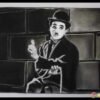Short Info & History
Impasto Painting is technique where paint is applied thickly, creating texture with visible brush or palette knife strokes. It is originated during the Renaissance, gained prominence in the Baroque period. Notable artists include Rembrandt, Vincent van Gogh, and Jackson Pollock.
On the other hand, Encaustic Painting (Hot Wax Painting)is a method of creating artworks using heated beeswax mixed with colored pigments. It dates back to ancient Egypt, Greece, and Rome. Notable examples include the Egyptian Fayum mummy portraits. Artists like Jasper Johns and Benjamin Calau have used this medium.
Composition
The Materials use for Impasto Painting are thick paint, often oil or acrylic, applied with brushes, palette knives, or other tools, which Creates texture and depth through the thickness of the paint.
But, In Encaustic Painting, we blend heated beeswax with pigments and sometimes damar resin for hardness and shine. Artists can use powdered pigments, colored wax, inks, or oil paints for pigmentation. It provides a smooth, flexible medium that can be manipulated when warm.
Specific Properties
Some specific prperties of Impasto Painting are
- Thickness: The thick application of paint creates a raised, textured surface.
- Light Interaction: The texture interacts with light, adding depth and dimension to the artwork.
- Drying Time: Takes longer to dry due to the thickness of the paint.
On the contrary, for Encaustic Painting...
- Surface: Can be done on prepared wood, plaster, or canvas. The surface should be solid and porous.
- Manipulation: Remains workable as long as it's warm, allowing for manipulation with various tools.
- Durability: When cooled, it forms a protective layer that preserves the artwork.
Key Features
The key features of Impasto Painting are
- Brushstrokes: Visible brush or palette knife strokes add a personal touch to the artwork.
- Three-Dimensional: Creates a three-dimensional quality, making the artwork more engaging.
- Expressiveness: Allows artists to convey emotions and sensations through texture.
Yet, for Encaustic Painting, the key features are...
- Glossy Effect: Shares qualities with oil paints, providing a glossy and appealing effect.
- Thermal Malleability: Can be sculpted, layered, or coated.
- Quick Drying: Prevents colors from bleeding into one another.
Surface or Media
Impasto Painting can be applied to various surfaces, including canvas, wood panels, and paper. The choice of surface affects the final appearance and durability.
Encaustic Painting traditionally done on wooden panels, but uncured Masonite, medium-density fiberboard, and heavy paper can also be used. The surface should be prepared to prevent warping or damage from heat.
Other Specialties
Impasto Painting can be combined with other techniques and materials, such as collage, to create unique and innovative artworks. Adding layers of paint adds depth and complexity to the piece.
Encaustic Painting allows for cutting, carving, stamping, or sculpting the paint, providing a 3D effect.It can be combined with other mediums, such as oil paints, pastels, and collage materials.It requires specific conditions and care, including fusing and binding the paint with a heat lamp or heat gun, and routine buffing to maintain the shine.
Vegan-Friendly and Toxicity
Now-a-days, Impasto Painting materials can be vegan-friendly with cruelty-free and non-toxic paint options. There are also Non-toxic alternatives are available for materials that may pose health risks, such as cadmium-based paints.
Encaustic Painting is generally safe to use with wax as a binder and pigments as a binding agent. It can be vegan-friendly if acrylic wax or other plant-based waxes like soy or carnauba wax are used instead of beeswax. Pigments should be free from animal-derived ingredients.
Conclusion
Both impasto and encaustic painting offer unique and versatile techniques that allow artists to explore new possibilities and push the boundaries of their creativity. Impasto painting focuses on the thickness and texture of paint, creating a three-dimensional quality, while encaustic painting uses heated wax for vibrant colors and intricate textures. Each method has its own specific properties, key features, and requirements, providing artists with a rich and rewarding artistic journey.














Leave a Reply